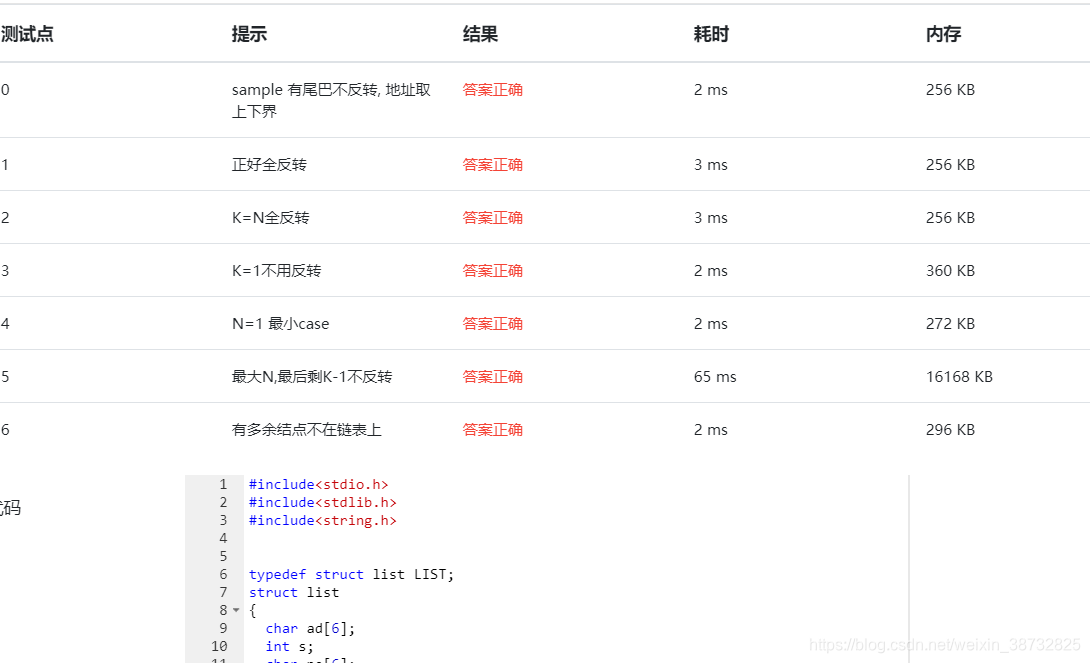Given a constant K and a singly linked list L, you are supposed to reverse the links of every K elements on L. For example, given L being 1→2→3→4→5→6, if K=3, then you must output 3→2→1→6→5→4; if K=4, you must output 4→3→2→1→5→6.
Input Specification:
Each input file contains one test case. For each case, the first line contains the address of the first node, a positive N (≤10
5
) which is the total number of nodes, and a positive K (≤N) which is the length of the sublist to be reversed. The address of a node is a 5-digit nonnegative integer, and NULL is represented by -1.
Then N lines follow, each describes a node in the format:
Address Data Next
where Address is the position of the node, Data is an integer, and Next is the position of the next node.
Output Specification:
For each case, output the resulting ordered linked list. Each node occupies a line, and is printed in the same format as in the input.
Sample Input:
00100 6 4
00000 4 99999
00100 1 12309
68237 6 -1
33218 3 00000
99999 5 68237
12309 2 33218
Sample Output:
00000 4 33218
33218 3 12309
12309 2 00100
00100 1 99999
99999 5 68237
68237 6 -1
#include<stdio.h>
#include<stdlib.h>
#include<string.h>
typedef struct list LIST;
struct list 定义一个结构体,ad代表当前节点地址;ne代表下个节点地址
{
char ad[6];
int s;
char ne[6];
LIST* next;
};
void link(char *ad, int s, char *ne,LIST** rear)///建立一个节点放到rearg后同时rear后移到新建节点p
{
LIST* p;
p= (LIST*)malloc(sizeof(LIST));
strcpy(p->ad,ad);
strcpy(p->ne,ne);
p->s = s;
p->next = NULL;
(*rear)->next = p;
(*rear) = p;
}
LIST* read(int m)//将输入的节点连成一个链表
{
char ad[6], ne[6];
int s;
LIST* head, *rear,*t;
rear = (LIST*)malloc(sizeof(LIST));
rear->next = NULL;
head = rear;
while (m--)
{
scanf("%s%d%s", ad,&s,ne);
link(ad, s, ne, &rear);
}
t = head;
head = head->next;
free(t);
return head;
}
LIST* sort(LIST* p1, char ad[6])/将读入的链表按其储存的ad,ne重新连接;
{
LIST* l1, *l2;
l1 = p1;
LIST* head, * rear;
rear = (LIST*)malloc(sizeof(LIST));
strcpy(rear->ne,ad);
rear->next = NULL;
head = rear;
while (1)
{
while (l1)
{
if (strcmp(l1->ad,rear->ne)==0)
{
link(l1->ad, l1->s, l1->ne, &rear);
}
l1 = l1->next;
}
l1 = p1;
char str[6] = "-1";/ ne为-1代表链表结束
if (strcmp(rear->ne,str)==0)break;注意
}
l2 = head;
head = head->next;
return head;
}
void insert(char ad[10], int s, char ne[10], LIST** rear1,LIST **rear2)///新建一个节点储存数据并将其插到rear1和rear2中间
{
LIST* p;
p = (LIST*)malloc(sizeof(LIST));
strcpy(p->ad,ad);
strcpy(p->ne,ne);
p->s = s;
p->next = (*rear2);
(*rear1)->next = p;
(*rear2) = p;
}
LIST* result(LIST* p1,int n)//将sort得到的链表再按规定反转
{
int z,m=0;
LIST* l1;
l1 = p1;
while (l1)//重新确定链表长度m
{
m++;
l1 = l1->next;
}
l1 = p1;
if (m < n) {//链表长度小于反转长度,全部反转
n=m;
}
if (n == 0 || n == 1)return l1;
else
{
z = m / n;//z为需要反转的子链个数
int k = n;
LIST* head, * rear,*p,*p1;
rear = (LIST*)malloc(sizeof(LIST));
rear->next= NULL;
head = rear;
p = rear;
p1 = rear;
while (z)
{
int flag = 1;//区分第一次进入循环的情况
while (k)
{
if (flag)///第一次进入循环就将其连接到rear后面
{
link(l1->ad, l1->s, l1->ne, &rear);
p = rear;
flag = 0;
//printf("%s %d %s\n", p->ad, p->s, p->ne);
}
else //不是第一次就将其插入到头节点与下一个节点之间
{
insert(l1->ad, l1->s, l1->ne, &p1, &p);
//printf("%s %d %s\n", p->ad, p->s, p->ne);
}
l1 = l1->next;
k--;
}
z--;
if (z!= 0)
{
k = n;
p1 = rear;
}
}
if (l1)///如果l1此时不为空说明当前链表节点不是需要反转节点的整数倍
rear->next = l1;然后将l1后的节点link到rear后面
p = head;
head = head->next;///释放空的头节点
free(p);
return head;
}
}
void print(LIST* p)打印链表
{
LIST* p1;
p1 = p;
while (p1)
{
printf("%s %d %s", p1->ad, p1->s, p1->ne);
printf("\n");
p1 = p1->next;
}
}
LIST* daan(LIST* p1, LIST* p2)///将sort中的再次与result得到的整和到sort
主要改变节点的ne,使其对应下一个节点的地址
{ /对于最后一个节点将其ne值置为-1代表链表结束下一个指向为null 返回p1
LIST *l1, * l2;
l1 = p1; l2 = p2;
char str[6] = "-1";
/*strcpy(l1->ad, l2->ad);
l1->s = l2->s;
strcpy(l1->ne, l2->next->ad);
l1 = l1->next;
l2 = l2->next;*/
while (l2->next)//
{
l1->s = l2->s;
strcpy(l1->ad, l2->ad);
strcpy(l1->ne,l2->next->ad);
l1 = l1->next;
l2 = l2->next;
}
l1->s = l2->s;
strcpy(l1->ad, l2->ad);
strcpy(l1->ne, str);
return p1;
}
int main()
{
LIST* p1, *p2,*p3,*p4;
char ad[6];
int m, n;
scanf("%s%d%d", ad, &m, &n);
p1 = read(m);
//print(p1);
p2 = sort(p1,ad);
/*print(p1);*/
p3 = result(p2,n);
p4 = daan(p2, p3);
print(p4);
return 0;
}在这里插入代码片






















 181
181











 被折叠的 条评论
为什么被折叠?
被折叠的 条评论
为什么被折叠?








